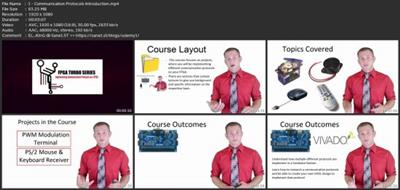Fpga Turbo Series - Communication Protocols
Last updated 11/2016
MP4 | Video: h264, 1920x1080 | Audio: AAC, 44.1 KHz
Language: English | Size: 1.33 GB | Duration: 1h 49m
Implementing fully functional communication protocols on your FPGA development board
What you'll learn
Implement virtually any communication protocol on their FPGA development board.
Improve their skill sets in FPGA development platforms, specifically Vivado's Design Suite.
Gain an understanding of various communication protocols.
Have their very own set of working VHDL design files.
Learn how to use the Xilinx development tool Vivado to implement, simulate, and program Xilinx FPGAs.
Requirements
Download and install Xilinx Vivado Design Suite. There are instructions on how to do so if you get stuck.
Download and install TeraTerm or any other type of terminal emulator. There are instructions on how to install TeraTerm included in this course if you happen to get stuck.
Basic understanding or exposure to VHDL.
Basic understanding of digital circuits.
Familiar with what a Field Programmable Gate Array (FPGA) is.
Description
This course*explains how multiple communication protocols are used and how they can be implemented onto a FPGA. Each communication protocol is explained in great detail so that the student will be able to successfully implement the communication protocol on their FPGA development board. After each communication protocol has been introduced and explained the students will then be tasked with completing a project that pertains to that specific communication protocol. These various projects and topics include
Generating PWM SignalsControlling a BuzzerControlling a RC*servo motorPS/2 Computer Keyboard CommunicationPS/2 Computer Mouse CommunicationReceiving Infrared Communication CommandsTransmitting Infrared Communication Commands
Students will be provided with VHDL design files that can be used as starting points for the*various design projects. Working with the provided design files and using the lectures as references the students will implement fully functional communication protocols*on their development boards. The students will get to use Xilinx's development tools for the*design and debugging of their various communication protocol implementations.
This course is geared towards students who have been exposed to VHDL, FPGA's, as well as a*basic understanding of digital circuits. This is a great supplement to any engineering student who wants to improve upon their hardware design skills before entering the workforce. This*course is also great for anyone who is currently employed*in the field engineering. Also any electronic hobbyist would benefit greatly from this course!
Upon completing this course students will have all the skills and knowledge to implement virtually any communication protocol on a FPGA. Beings that the students will be designing and debugging their own code they will have very detailed knowledge of how each design works and will be able to expand upon each project if they so desire.
Overview
Section 1: Introduction
Lecture 1 Communication Protocols Introduction
Lecture 2 Course Materials
Section 2: Pulse Width Modulation (PWM)
Lecture 3 Introduction to Pulse Width Modulation (PWM)
Lecture 4 PWM Waveforms
Lecture 5 PWM Buzzer Control
Lecture 6 PWM Servo Control
Section 3: Pulse Width Modulation Project
Lecture 7 PWM Design Assignment
Lecture 8 Simulating your PWM Design in Vivado
Lecture 9 PWM Terminal Project
Lecture 10 PWM Terminal Demonstration
Section 4: PS/2 Communication Protocol
Lecture 11 Introduction to PS/2
Lecture 12 PS/2 Protocol
Lecture 13 PS/2 Keyboard Interface
Lecture 14 PS/2 Mouse Interface
Section 5: PS/2 Interface Design Projects
Lecture 15 PS/2 Mouse Receiver Project
Lecture 16 PS/2 Mouse Receiver Demonstration
Lecture 17 PS/2 Keyboard Receiver Project
Lecture 18 PS/2 Keyboard Receiver Demonstration
Section 6: Infrared Communication Protocol
Lecture 19 Infrared Communication Introduction
Lecture 20 Infrared Data Transmission
Section 7: Infrared Receiver Design Project
Lecture 21 Infrared Receiver Design Project
Lecture 22 Infrared Receiver Demonstration
Section 8: Infrared Transmitter Design Project
Lecture 23 Loading Designs on the BASYS 3 Board Using the USB Port
Section 9: References
Lecture 24 TeraTerm Download and Installation
Lecture 25 Vivado Download and Installation
Lecture 26 Creating a Project in Vivado
Section 10: Conclusion
Lecture 27 Conclusion
You should take this course if: You have completed my Learn VHDL and FPGA Development course.,You should take this course if: You have completed my FPGA Turbo Series - Implementing a UART course.,You should take this course if: You have prior experience working with VHDL and FPGA's.,You should not take this course if: You have no prior VHDL, FPGA, or digital circuit knowledge.
Download link
rapidgator.net:
uploadgig.com:Kod:https://rapidgator.net/file/754d55b5a72b919d57988adee702b6e0/krtio.Fpga.Turbo.Series..Communication.Protocols.part1.rar.html https://rapidgator.net/file/43e3672d79d0d991097abb6e1a1c1bc5/krtio.Fpga.Turbo.Series..Communication.Protocols.part2.rar.html
nitroflare.com:Kod:https://uploadgig.com/file/download/189C80ba70bc9C57/krtio.Fpga.Turbo.Series..Communication.Protocols.part1.rar https://uploadgig.com/file/download/dec4510014b3E6cC/krtio.Fpga.Turbo.Series..Communication.Protocols.part2.rar
1dl.net:Kod:https://nitroflare.com/view/B2066CFA17E7684/krtio.Fpga.Turbo.Series..Communication.Protocols.part1.rar https://nitroflare.com/view/336AB9614C0C7E3/krtio.Fpga.Turbo.Series..Communication.Protocols.part2.rar
Kod:https://1dl.net/b0vp2wz8emae/krtio.Fpga.Turbo.Series..Communication.Protocols.part1.rar.html https://1dl.net/e4wwm39r7pb4/krtio.Fpga.Turbo.Series..Communication.Protocols.part2.rar.html
1 sonuçtan 1 ile 1 arası
-
02.11.2022 #1Üye



- Üyelik tarihi
- 20.08.2016
- Mesajlar
- 144.947
- Konular
- 0
- Bölümü
- Bilgisayar
- Cinsiyet
- Kadın
- Tecrübe Puanı
- 153
Fpga Turbo Series - Communication Protocols
Konu Bilgileri
Users Browsing this Thread
Şu an 1 kullanıcı var. (0 üye ve 1 konuk)



 LinkBack URL
LinkBack URL About LinkBacks
About LinkBacks






 Alıntı
Alıntı
Konuyu Favori Sayfanıza Ekleyin